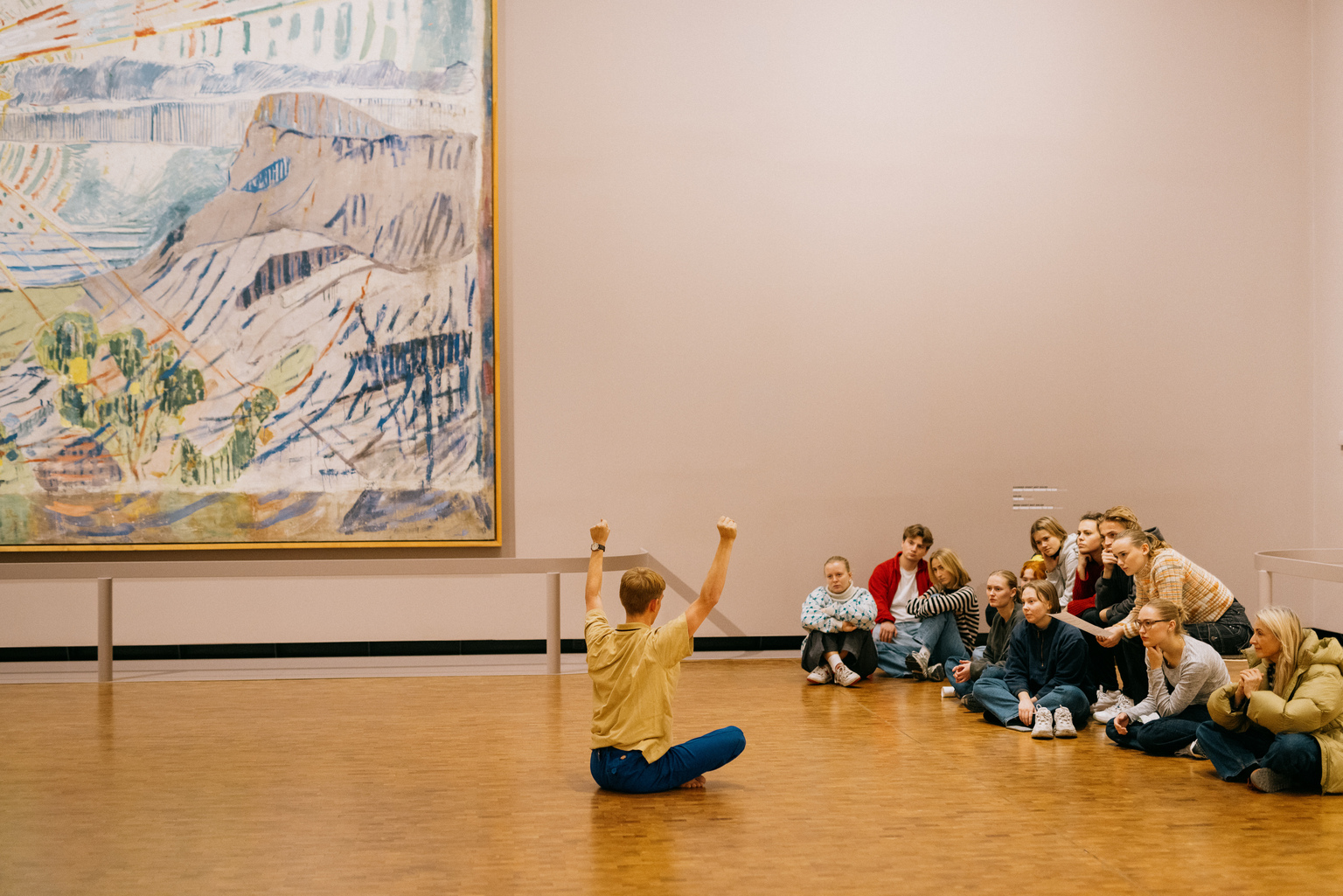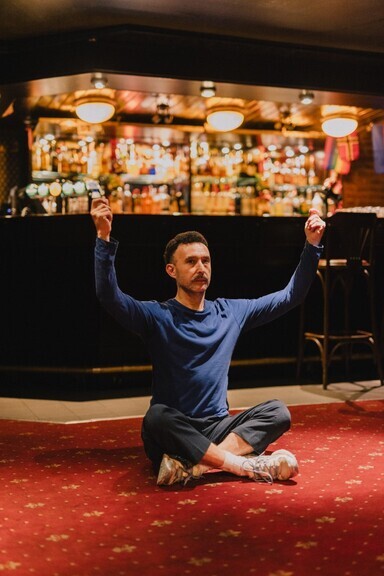Disputas

Disputas: Manuel Pelmus
Manuel Pelmus forsvarer resultatet av sitt kunstneriske utviklingsarbeid Permanent Collection - simultaneous ongoing action.
Manuel Pelmus er ph.d.-stipendiat i programmet for kunstnerisk utviklingsarbeid ved Kunstakademiet, Kunsthøgskolen i Oslo.
Det kunsteriske utviklingsarbeidet er tilgjengelig i Kunsthøgskolens vitenarkiv KHIODA.
Sammendrag av prosjektet
For this artistic research project, I am particularly interested to explore how notions of liveness, movement, and performativity are invested in reimagining political, collective, and social forms of organisation. How they relate to reconfiguring the public sphere in the sense of forms of community, and to notions of memory and collective history. The conceptual framework for this artistic research project developed during the last years of my artistic practice (alone and in collaboration) working with performance and live works within the context of the visual art field. Through this hybrid framework, I was able to reflect on a range of artistic and political topics that have circulated recently in the field of art and are informed by what is generically called the new performative turn in the arts.
In this sense Permanent Collection will function as a trigger or a starting point addressing the current international debate on how this recent performative turn of dance and choreography in the arts is “invested in contesting late modernist formulations and structures, and how it reevaluates discourses of institutional critique, queer theory, postcolonial theory” (Ana Janewski & Cosmin Costinas), and relates them to un/writing of history, often by means of radical choreography.
My artistic aim is to put in motion different performative strategies using mainly the human body, in order to complicate and challenge established categories permeating the field of arts and society at large, such as preservation, originality, value production, ownership, collectivity, spectatorship, politics of history and politics of display.
I am particularly interested in (art) institutions as places where long term politics are enacted and played out, but also as devices that archive, classify, record and categorise artefacts and events, write history and reflect on society. I want to mobilise these conventions by means of presence and performativity with the aim of actualising and rethinking them anew.
I will produce three works during the three years of research. These works will built on each other and will be presented through formats and protocols specifically designed during the research period aiming at rethinking forms of spectatorship and attention, and the politics they produce.
Bedømmelseskomité
Apolonija Sustersic
Pablo Martinez
Sara Eliassen
Apolonija Sustersic
Committee leader: Apolonija Sustersic, is a visual artist, architect and researcher. Her work is related to a critical analysis of space, usually focused on institutional and cultural politics, urban planning and architecture. Her interest starts with the phenomenological study of space and continues its investigation into the social and political nature of our living environment. She usually does extensive research into specific situations found on location, which she uses as a starting point. The result isn’t only presented as analytical criticism, but it produces in itself already a suggestion for the future. She is interested in finding alternative possibilities and making proposals from a hybrid point of view that ranges beyond art and architecture, making socially committed works naturally taking the form of everyday life activity. Her practice is embedded within the interdisciplinary discourse and usually includes collaborations with other professionals such as architects, urban planners, curators, sociologists, and the local population. Sustersic has a PhD from the University of Lund, Malmö Art Academy, Sweden; she is running her own studio practice in Oslo. She has taught at Oslo National Academy of the Arts, Head of MFA Program: Art & Public Space. She has been invited to a number of internationally published and exhibited projects and exhibitions within and beyond the international contemporary art institutions around the world, like Moderna Museet Stockholm, Berlin Biennale 2, Luxembourg City of Culture, Moderna Galerija Ljubljana, Marian Goodman, Paris, De Appel, Amsterdam, Generali Foundation, Vienna, Art Museum, University of Memphis, USA, Tirana Biennale 3, Tirana, Muhka, Antwerp, Edinburgh International Festival, Bildmuseet, Umeå, Galerie für Zeitgenossische Kunst, Leipzig, 12th Architecture Biennale, Venice, Artes Mundi 5, Gwangju Biennial among others.
Pablo Martinez
First opponent Pablo Martinez, Pablo Martínez holds a PhD in art history, for which he carried out an investigation into the images of the crowds taken at the funeral of Spanish anarchist Buenaventura Durruti. He works as Margarita Salas researcher at the Institute of History of CSIC (Spanish Council of Scientific Research). Over the last decade, his institutional work has sought to challenge the limits of the museum in order to imagine an eco-social institutionality. He was Director of Programmes at MACBA (2016–2021), and prior to this he was Head of Education and Public Activities at CA2M (2009–2016). Between 2012 and 2015 he worked as an associate professor at the Faculty of Fine Arts, Universidad Complutense de Madrid. He has edited books, curated performances, activated collective processes of creation, accompanied artists in residence and curated exhibitions. He has also negotiated with neighbours, protested against the extension of the MACBA building, moved chairs, placed bottles of water, made applications and danced until sunset. His current research and practice is oriented towards the ecological crisis and the role of art in the construction of a new hegemony that might enable a less violent and more just transition. He tries to go out dancing whenever he can.
Sara Eliassen
Sara Eliassen is an artist and filmmaker based in Oslo. She received her PhD in artistic research at Oslo National Academy of Arts— Academy of Fine Art, with the ongoing research project Mediating Uncertainties. Current investigations explore propaganda histories, and how ideologies are normalized through contemporary images, technologies and moving image culture. Eliassen’s projects move between exhibition spaces, cinemas and sites in the public sphere. Her work is exhibited in Norway and internationally, most recent solo-exhibitions: Images [and Talking Back to Them] at Kunstnernes Hus in Oslo (2023), and an up-coming solo-exhibition at Laboratorio Arte Alameda in Mexico City (2024). Her films have played extensively at film festivals, such as Venice Film Festival, Int. Film Festival Rotterdam and Sundance. Site-specific projects include Not Worth It (2007), Under The Park (2021), and The Feedback Loop with The Munch Museum in Oslo (2018). She also programs films, lectures and conversations; inviting and commissioning other artists in relation to her own research and projects. Eliassen participated in the Whitney Independent Study Program as a studio fellow after completing her MFA in the film department at San Francisco Art Institute (2010).
Veiledere
Dora Garcia, hovedveileder
Catherine Wood, medveileder
